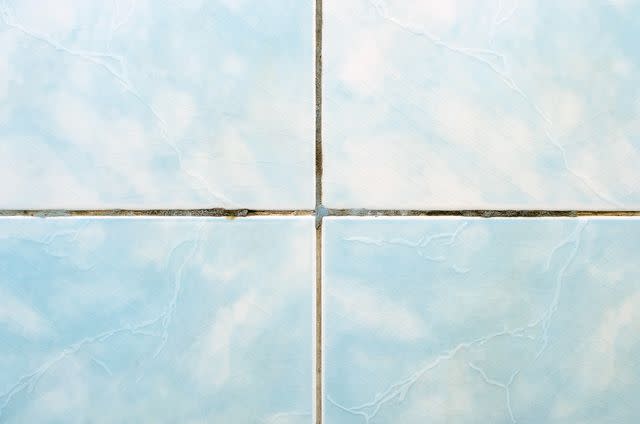Mildew vs. Mold: What You Need to Know
You don't want either mold or mildew lurking in your home.
Mildew and mold can pop up in even the cleanest homes—whether it's because of a hidden leak in a bathroom, a spot that doesn't get cleaned on the regular, or an overly humid basement. But many people use the words mold and mildew interchangeably when they're discussing those icky dark spots that creep into tile grout or along the edges of drywall. So are mold and mildew the same thing—and how do you prevent them from making an appearance?
Get the scoop on the mold vs. mildew debate, with expert advice from mold expert and HomeCleanse founder Michael Rubino.

Natalya Vilman/Getty Images
What Is Mold?
Molds are actually fungi (like mushrooms!)—and they thrive on moisture and oxygen. They help break down dead material in nature, which is great when it happens outdoors to fallen tree logs, but not so great when it happens indoors, where it can rot away wood, insulation, or other parts of the house if left unattended. Mold spores can also waft through the air to other parts of the house, and spread if not addressed.
If you have mold in your house, it can cause allergy-like symptoms (think a runny nose and sneezing), rashes, or make asthma worse.
What Is Mildew?
Short answer: Mildew is just a different type of mold. "The term 'mildew' basically refers to mold growth that’s light in color and powdery in texture," Rubino says. "These mold colonies could be gray, white, or light green and grow in a flat format without much height, meaning they aren’t as fluffy and sponge-like as some other mold growth."
Related: 8 Signs There May Be Mold and Mildew in Your House
How to Prevent Mildew vs. Mold
You can use the exact same tactics to prevent mold and mildew, since they're essentially the same thing. Rubino recommends the following to help keep mold from cropping up in the first place.
Reduce moisture in the house
That means mopping up spills or pooled water, fixing leaks or structural issues that could allow water in promptly, leaving your dishwasher and washing machine open to dry out, and making room for wet items like bathmats, shower liners and curtains, and towels to dry out.
Maintain humidity levels between 35 to 50 percent—which may require investing in a dehumidifier for your basement or other humid areas, and using the exhaust fan or opening a window when you shower or cook in the kitchen.
Maintain your house
Cleaning your house does more than just help it look good—it can help keep mold and mildew (and icky critters) at bay, too. Rubino recommends using botanical cleaning products and HEPA vacuum cleaners, and making sure you dust and deep clean regularly.
Take steps to improve air quality
Cleaning the air in your home can go a long way toward reducing mold and mildew—along with bacteria, pet dander, and other things you definitely don't want in your home. Keep your HVAC system well maintained and use the highest grade MERV filters to help reduce contaminants in your air. Air purifiers are also effective at preventing mold and mildew (and can help reduce dust, allergens, and even bacteria and viruses, too).
Related: The 15 Best Air Purifiers of 2023, Tested and Reviewed
What to Do If You Find Mold or Mildew
Don't panic! There are safe ways to clean mold and mildew from your house. And once it's gone, just follow the prevention steps above to help keep it from resurfacing. Here's what you need to know to clean away the mold or mildew.
Eliminate the source
In order to stop mold from coming back, you need to remove it all at its source. "All of the contamination must go," Rubino says. "This includes the colony, roots, dead mold particles, mycotoxins, and any bacteria present. If all of these boxes aren’t checked, the mold colony could still be there, and/or the indoor space could be packed full of harmful microscopic particles."
Tailor the treatment to the area where the mold is
If the mold is on a nonporous surface like a tile or a sealed countertop, you can use a botanical cleaner (Rubino recommends Benefect Decon 30). Just let it sit for 30 seconds, then use a microfiber cloth to wipe away the product, as microfiber towels can clean away 100 times more particles than traditional rags. Repeat the process at least three times to ensure all contaminants, including mycotoxins, which are toxic byproducts that some species of mold release, are removed.
Do not use bleach
Bleach has been touted as an antiseptic and anti-mold cleaner, but bleach is ineffective at actually removing the mold or mildew, which is the key to removing the mold, according to the Environmental Protection Agency.
Surfaces that are semi-porous (like grout or hardwood flooring) can be trickier to clean. "The roots of the mold can grow into the surface itself and be difficult to remove completely," Rubino says. "For the surface to be contaminant-free, all particles must be removed."
He recommends following the same cleaning process as for nonporous surfaces, and sealing the surface after it's been cleaned. If you're cleaning grout or caulk, hydrogen peroxide can make it easier to wipe away the mold—then watch to see if it returns quickly, which could indicate a bigger problem that requires professional help.
As for porous surfaces, Rubino recommends removing and replacing the item, as the contamination may prove too hard to remove.
For more Real Simple news, make sure to sign up for our newsletter!
Read the original article on Real Simple.


